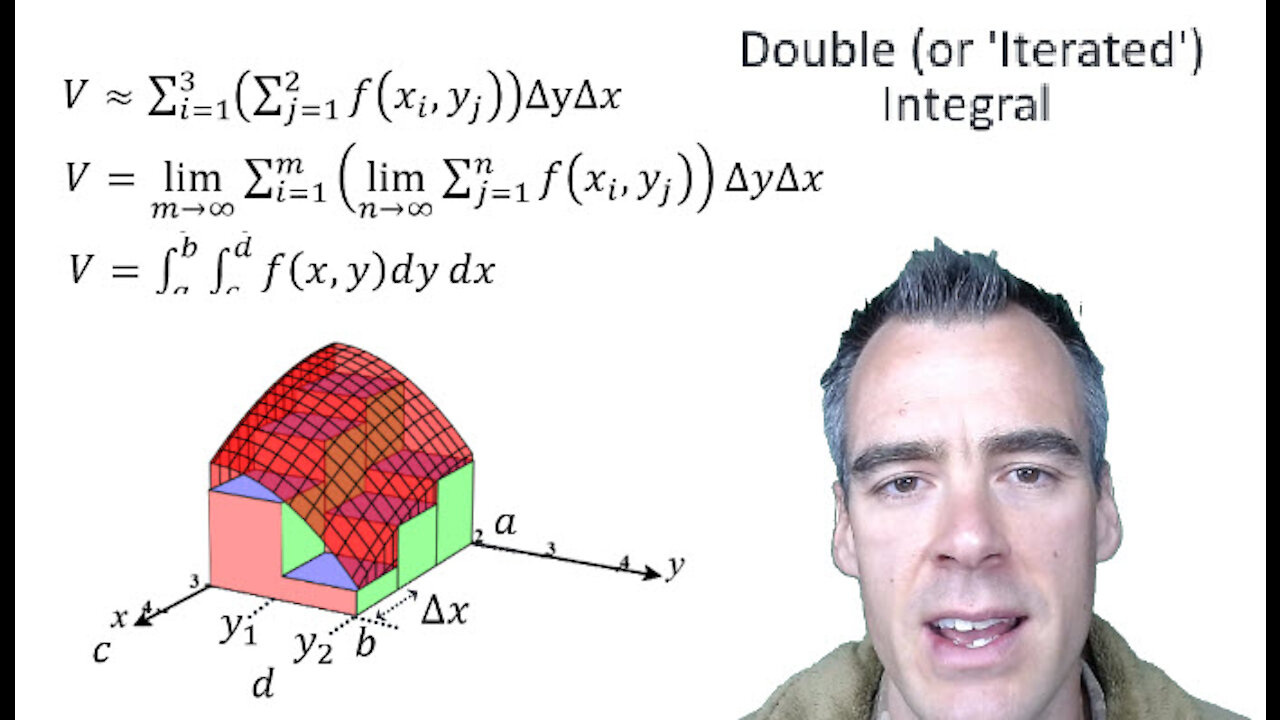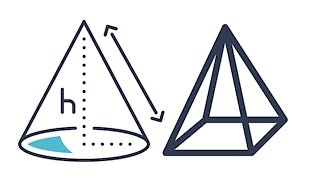Premium Only Content

Introducing the Double Integral: Finding Volume Under Surface
Having looked at a Riemann Sum for approximating a volume in the last video, we now see how to transition this into an infinite Riemann Sum and finally into an integral, just as you may recall doing in integral calculus.
Suppose we wanted to find the area under our function f(x) between the points a is less than x is less than b. We break this up into m rectangles and sum up their areas to approximate the area under the curve, where Δx=(b-a)/m
and f(x_i ) was the height for each rectangle. And to find the exact area, we added up an infinite number of infinitesimally thin rectangles, and this infinite sum turned out to be the very definition of the integral.
Now in 3-space, suppose we have a surface f(x,y)=24-x^2-y^2/3 and we wanted to find it’s volume between 0 is less than x is less than 3 and 0 is less than y is less than 2.
As in the previous video, we can estimate this volume by summing up some rectangular columns, each column of width and length Δx and Δy. We can formally define the widths as Δx=(b-a)/m=(3-0)/3=1 where a and b would be the lower and upper x limits of 0 and 3 and each has a height of the surface value at the corresponding x and y coordinates. So the volume of each rectangular column is ΔxΔy f(x_i,y_j). More generally we can call that ΔxΔy=ΔA for the area of each of chunk where i is like the i values in our integral calculus example, and j is our index for y.
Now we can add up these rectangular solids like we did in the previous video, but we’ll use summation notation this time to find our approximate volume. We'll use a summation nested within another summation because we are adding the heights for each of the 2 y increments, and doing that 3 times for each of the x increments, for what amounts to a total of 6 rectangular columns.
Now comes the fun part, we can find the exact volume by summing up an infinite number of rectangular columns that are infinitesimally thin in the x and y directions.
To do that me make some modifications to our prior equation by replacing our 3 increments in the x direction and 2 increments in the y direction with variables m and n, respectively, and taking the limit of our summation as m and n both approach infinity. This gives us our exact volume, so again we have one summation nested inside another, but these are infinite summations now, and we know that infinite sums of this form are the very definition of integrals, so we could change the inside summation to an integral where we brought that dy to the inner integral
and we could change the outside summation to an integral as well:
So above is the general form of a double integral to find the exact volume of a solid in 3-space. But to go back and apply this the problem we did in the previous video, that c and d were our y limits of 0 and 2 in this case, and that a and b were our x limits of 0 and 3 in this case, and that f(x,y) was our function 24-x^2-3y^2 .
In the next video we’ll go ahead and evaluate this using some basic calc2 skills while simultaneously showing how to evaluate it in MATLAB.
-
 1:44
1:44
String Theory Music
4 years ago $0.03 earnedGuitar - Under the Double Eagle
3752 -
 0:21
0:21
ViralHog
6 years ago $0.01 earnedSomething Unexpected Under The Surface
618 -
 7:43
7:43
IntoMath Grade 9 Lessons
4 years ago $0.22 earnedSurface Area and Volume - Pyramid and Cone - IntoMath
513 -
 2:42
2:42
KMTV
5 years agoCustomers finding they're being double charged for groceries
10 -
 0:31
0:31
MaxandKatietheGreatDanes
5 years agoGreat Dane Relaxes Under Florida Double Rainbow
391 -
 0:50
0:50
JessPowell
4 years ago $0.01 earnedMe finding sleepy Callie under blankets and annoying her
941 -
 0:55
0:55
Buri0416_raccoon
4 years agoRaccoon lies down and enjoys finding the feet of his family under the trampoline.
492 -
 0:44
0:44
TRISTOM307
4 years ago $0.04 earnedDouble crossbow
330 -
 0:05
0:05
bubbowhunter
4 years ago $0.03 earnedDouble jointed?
493 -
 1:14
1:14
WFTS
5 years agoDouble homicide under investigation in Largo
52